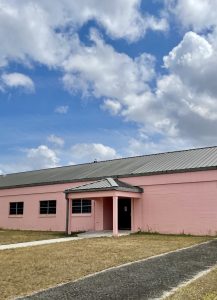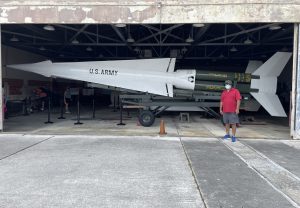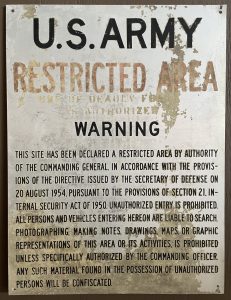
Missile base tour tells 1960s Cold War story
HOMESTEAD, Fla. — Leon Howell stands in front of the former headquarters of the Nike Hercules Missile Base in Everglades National Park and surveys the tour group in front of him. Despite the hat and sunglasses obscuring half his face, his grim expression is apparent.
“Now, I don’t care where you lived in this country, or in many developed Western nations around the world: you thought the world might be coming to an end,” said Howell as he recounted his memory of Oct. 22, 1962 — the day that President John F. Kennedy appeared on national television to notify Americans of the Soviet missiles found in Cuba.
 |
Former military headquarters of HM69, now the Daniel Beard Research Center (Photos by Carolene Kurien). |
Howell, former member of the U.S. Coast Guard, is an interpretive park ranger at Everglades National Park and has been giving tours of the park’s Cold War-era missile base since it opened to the public in 2009.
Nike Hercules Missile Base, aka HM69, was formally established in 1965 and was referred to as “Alpha Battery” to distinguish it from the three other military batteries erected in South Florida around the same time.
Missile bases like HM69 were constructed after the Cuban Missile Crisis to safeguard the country against any potential attacks from the south and to prepare for the possibility of a nuclear war.
“Duty here was tense. This was front line defense. This would have been an initial target,” said Howell.
To the nation’s relief, no such nuclear war occurred, and HM69 was deactivated in 1979 and turned over to the National Park Service. It now serves as a tourist attraction for those interested in learning more about the military history of the U.S. and South Florida in particular.
HM69 is composed of 22 buildings and structures which include three missile barns, a missile assembly building, a guard dog kennel and barracks.
Of them all, the headquarters is the most prominent. It is a bubblegum pink building which, when back-dropped with a baby blue sky, looks like something out of a Wes Anderson film.
This charming exterior doesn’t exactly scream military, but that’s the point.
| The writer’s father stands next to the original Nike Hercules missile featured in the missile barn. |  |
“The logic is, if you are an enemy aircraft flying overhead, and you see [a] building this pink, you’re not going to really think it is an army building, right? So, it’s camouflaged, it’s hidden in plain sight,” said Daniel Agudelo, another park ranger and Nike Missile Site coordinator.
Aside from the military headquarters, now a research center, visitors can observe and learn more about the other structures in the site throughout the tour. They also have the chance to go into one of the missile barns, which contains an original Nike Hercules missile.
Along with the missile, the barn contains missile components, war memorabilia, pictures and the original warning sign from the site stating that it was a “U.S. Army Restricted Area.”
“Had you tried to get in here back then, if the dogs didn’t get you, you’d have been shocked. It is that simple,” said Howell.
What was not so simple were the 1960s. Though it was the decade that brought the Civil Rights Act of 1964, the first Super Bowl, the first moonwalk and Woodstock, it was also the decade that saw the assassinations of John F. Kennedy, Martin Luther King Jr. and Robert Kennedy, as well as the Vietnam and Cold Wars.
“What a contradictory world these soldiers served in,” said Howell.
Along with living through these contentious times, the soldiers lived in a physical environment that became a challenge to endure in and of itself.
From mosquitos to eastern diamondback rattlesnakes, from severe thunderstorms to the blistering heat, soldiers stationed at HM69 had to find ways to cope with the Everglades’ harsh environment.
The following excerpt from a poem, written by an unnamed soldier who lived in one of the tents that served as shelters before the barracks were constructed, emphasizes the struggle that soldiers at HM69 faced:
In the Southern part of Florida
Battery A is the spot
where we are domed to die in
the land that God forgot…
But when we die and go to heaven
we will hear St. Peter yell
come on in Battery A soldier you’ve
spent your time in hell.
This poem was provided by Agudelo, who sympathized with the soldier.
“It wasn’t easy to live out here,” said Agudelo.
The demographic that would be able to connect the most with the soldiers’ struggles are other veterans, which explains why, as Howell and Agudelo mentioned, many of the visitors are either veterans or individuals who are connected to the military in some way.
One of the tour visitors, Lance J. Kreitzer, is both a history lover and a member of the University of Miami’s Air Force ROTC program.
 |
Original warning sign from when HM69 was an active missile base. |
“I’ve always wanted to serve; I have a bit of a connection to the military in my family. My grandfather was a captain in the army during Vietnam and all of my cousins on my mom’s side of the family all enlisted in the military, whether it be in the Marine Corps, the Air Force or the Army,” said Kreitzer.
Kreitzer didn’t even realize there was a missile base tour until he got to the park and saw a sign at the entrance advertising it.
It was a pleasant surprise for Kreitzer, who came to the Everglades to foster his love for national parks and left with his love for Air Force history nurtured as well.
“I definitely got more than I was expecting,” said Kreitzer.
While Kreitzer comes from a military family, one notable visitor Agudelo encountered last year was a soldier who was stationed at HM69 during its active years.
“One of the visitors said ‘ranger, yes, I was stationed out here, but I was one of the line cooks in that pink building. I had zero access to where the missiles are at, and now, because of your program, 50 years later, I can connect my own dots, and now I can see what my mates were doing down range,’” said Agudelo as he recounted his memorable interaction with the former HM69 soldier.
Though military and history buffs compose many of the visitors, the site is certainly not exclusive to them. People from all walks of life can find something compelling about HM69, as exemplified by artist Elizabeth Withstandley.
Withstandley was the January 2021 Artist in Residence in Everglades and is a current AIRIE Research Fellow. During her time at the park, Withstandley, an interdisciplinary artist, drew inspiration from many of the park’s various areas, the missile base included.
“You just really feel the history and you can feel the story there, that there’s lots of things that happened,” said Withstandley.
Agudelo hopes the site will continue to draw a larger variety of visitors and believes the HM69 tour is a good opportunity for Everglades National Park to combat the diversity issue that national parks face.
“The parks service has this issue with trying to find relevancy with historically underrepresented groups,” said Agudelo. “So, the fact that this Cuban Missile Crisis story is so close to the Hispanics and Latinos down here kind of adds that appreciation.”
Though HM69 may not be the first thing people associate with Everglades National Park, it is just as important to preserve as the millions of acres of unique flora and fauna.
Howell emphasized that the heart of the site are the stories of the soldiers, the young men who were willing to put their lives at risk to protect their fellow citizens.
“These were real people, just like today, and when we tell their stories from so long ago, we are actually bringing that past to the present, and in some way hope we can relate, because they were just like us.”
If You Go:
- Location: Daniel Beard Research Center, seven miles away from Ernest F. Coe Visitor Center (40001 State Hwy. 9336, Homestead, Fla., 33034).
- Admission: Free tour with park entrance fee ($30 per car).
- Tour season: December-April; dates vary depending on the year.
- Tour time: 2 to 3:30 p.m.
- Phone: 305-242-7700.
- Registration required: you can either call the park ahead of time to ensure your place or register at the Ernest F. Coe Visitor Center the day of your visit.
- Notes: Though the ranger-guided tour is only given in the afternoon, the site is open for visitors to tour by themselves from 10 a.m. to 2 p.m.

Comments are Closed